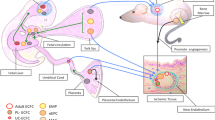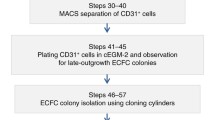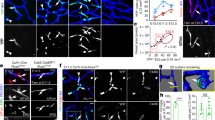Summary
Endothelial cell lines have been established from cells that were isolated from porcine yolk sacs from day 18 and day 22 embryos and propagated in vitro under various growth conditions. After expansion in vitro, the general properties of the cells proved similar for the different media used. The endothelial cells expressed cell surface receptors for acetylated low-density lipoprotein and also expressed cell surface-associated angiotensin-converting enzyme. The cells showed a characteristically high level of binding for Bandeiraea simplicifolia lectin I and Dolichos biflorus agglutinin but did not bind significant amounts of Ulex europaeus lectin I. The cells expressed low but serologically detectable levels of Class I major histocompatibility complex (MHC) antigens but failed to bind antibodies directed against Class II MHC antigens. α5β1 integrins were weakly expressed, whereas vascular cell adhesion molecule-1 (CD106) and αvβ3 integrins were not detected. Three-dimensional tube formation was readily observed in cultures grown on Matrigel and occurrel even in uncoated plastic dishes in the absence of Matrigel. In contrast to most of the adult porcine endothelial cells, yolk sacderived endothelial cells did not posses serologically detectable receptors for porcine growth hormone (GH), an observation consistent with the finding that GH did not increase the proliferative rate of these cells. Electron microscopic examination demonstrated the presence of Weibel-Palade bodies, tight endothelial cell junctions, and typical rough endoplasmic reticulum. Exposure of the cells to either concanavalin-A-stimulated porcine splenocyte culture supernatants or to human tumor necrosis factor α did not cause upregulation of VCAM-1 or Class II MHC antigens. Addition of prrcine interferon-γ led to an increase in the level of expression of Class I MHC. Yolk sac endothelial cells from day 22 embryos showed a low but detectable level of expression of Class II MHC antigens, whereas the endothelial cells from day 18 embryos showed no expression of Class II antigens after interferon-γ stimulation. The cells maintained competence to develop vascular structures in vitro and could do so after coinjection with murine tumor cells into adult, immunocompromised mice.
Similar content being viewed by others
References
Akhtar, N.; Dickers, E.; Auerbach, R. The sponge/Matrigel angiogenesis assay. Angiogenesis 5 (in press); 2002.
Auerbach, R. Vascular endothelial cell differentiation: organ-specificity and selective affinities as the basis for developing anti-cancer strategies. Int. J. Radiat. Biol. 60:1–10; 1991.
Auerbach, R.; Alby, L.; Grieves, J., et al. A monoclonal antibody against angiotensin-converting enzyme: its use as a marker for murine, bovine, and human endothelial cells. Proc. Natl. Acad. Sci. U.S.A. 79:7891–7895; 1982.
Bach, F. H. Xenotransplantation: problems and prospects. Annu. Rev. Med. 49:301–310; 1998.
Bach, F. H.; Robson, S. C.; Winkler, H., et al. Barriers to xenotransplantation. Nat. Med. 9:869–873; 1995.
Bracy, J. L.; Sachs, D. H.; Iacomini, I. Inhibition of xenoreactive natural antibody production by retroviral gene therapy. Science 281:1845–1847; 1998.
Butler, D. New front in an old war. Nature 406:670–672; 2000.
Cioffi, L.; Sturtz, F. G.; Wittmer, S., et al. A novel endothelial cell-based gene therapy platform for the in vivo delivery of apolipoprotein E. Gene Ther. 6:1153–1159; 1999.
Dickinson, E. S.; Slakey, L. L. Plasma-derived serum as a selective agent to obtain endothelial cultures from swine aorta. In Vitro 18:63–70; 1982.
Grant, D. S.; Lelkes, P. I.; Fukuda, K., et al. Intracellular mechanisms involved in basement membrane induced blood vessel differentiation in vitro. In Vitro Cell. Dev. Biol. 27A:327–336; 1991.
Gumkowski, F.; Kaminska, G.; Kaminski, M., et al. Heterogeneity of mouse vascular endothelium: in vitro studies of lymphatic, large blood vessel and microvascular endothelial cells. Blood Vessels 24:11–23; 1987.
Joziasse, D. H.; Oriol R. Xenotransplantation: the importance of the Galaphal, 3Gal epitope in hyperacute vascular rejection. Biochim. Biophys. Acta 145:403–418; 1999.
Knabel, M.; Kolle, S.; Sinowat, F. Expression of growth hormone receptor in the bovine mammary gland during prenatal development. Anat. Embryol. (Berl.) 198:163–169; 1998.
Li, J.; Wei, Y.; Wagner, T. E. In vitro endothelial differentiation of long-term cultured murine embryonic yolk sac cells induced by matrigel. Stem Cells 17:72–81; 1999.
Obeso, J.; Weber, J.; Auerbach, R. A hemangioendothelioma-derived cell line: its use as a model for the study of endothelial cell biology. Lab. Invest. 63:259–269; 1990.
Platt, J. L. New directions for organ transplantation. Nature 392:11–17; 1998.
Platt, J. L. New risks, new gains. Nature 407:28–30; 2000.
Plendl, J.; Hartwell, L.; Auerbach, R. Organ-specific change in Dolichos biflorus lectin binding by myocardial endothelial cells during in vitro cultivation. In Vitro Cell Dev. Biol. 29A:25–31; 1993.
Plendl, J.; Neumüller, C.; Vollmar, A., et al. Isolation and characterization of endothelial cells from different organs of fetal pigs. Anat. Embryol. 194:445–456; 1996.
Plendl, J.; Sinowatz, F.; Auerbach, R. A transformed murine myocardial vascular endothelial cell clone: characterization of cells in vitro and of tumours derived from the clone in situ. Virchows Arch. 426:619–628; 1995a.
Plendl, J.; Sinowatz, F.; Auerbach, R., et al. Quantitative differences in neoglycoprotein binding for vascular endothelial cells from porcine brain, ovary, and testis in vitro. Microvasc. Res. 50:199–214; 1995b.
Vandenbroeck, K.; Dijkmans, R.; Van Aerschott, A., et al. Engineering by PCR-based exon amplification of the genomic porcine interferon-gamma DNA for expression in Escherichia coli. Biochem. Biophys. Res. Commun. 180:1408–1415; 1991.
Vandenbroeck, K.; Martens, E.; D'Amdrea, S., et al. Refolding and single-step purification of porcine interferon-gamma from Escherichia coli inclusion bodies. Conditions for reconstitution of dimeric IFN-gamma. Eur. J. Biochem. 215:481–486; 1993.
Van der Laan L. J.; Lockey, C.; Griffeth, B. C., et al. Infection by porcine endogenous retrovirus after islet xenotransplantation in SCID mice. Nature 407:90–94; 2000.
Wang, S.-J.; Greer, P.; Auerbach, R. Isolation and propagation of yolk-sacderived endothelial cells from a hypervascular transgenic mouse expressing a gain-of-function fps/fes proto-oncogene. In Vitro Cell. Dev. Biol. 32A:292–299; 1996.
Wei, Y.; Li, J.; Chen, W. Y., et al. Human growth hormone antagonist (G120R) delivered by a murine yolk sac cell-derived mini-organ decreases the growth rate of mice. Stem Cells 15:364–367; 1997.
Wei, Y.; Quertermous, T.; Wagner, T. E. Directed endothelial differentiation of cultured embryonic yolk sac cells in vivo provides a novel cell-based system for gene therapy. Stem Cells 13:541–547; 1995.
Weiss, R. A. Transgenic pigs and virus adaptation. Nature 391:327–328; 1998.
Weiss, R. A. Tenografts and retroviruses. Science 285:1221–1222; 1999.
Yu, D.; Auerbach, R. Brain-specific differentiation of mouse yolk sac endothelial cells. Brain Res. Dev. Brain Res. 117:159–169; 1999.
Author information
Authors and Affiliations
Corresponding author
Rights and permissions
About this article
Cite this article
Plendl, J., Cilligan, B.J., Wang, SJ. et al. Primitive endothelial cell lines from the porcine embryonic yolk sac. In Vitro Cell.Dev.Biol.-Animal 38, 334–342 (2002). https://doi.org/10.1290/1071-2690(2002)038<0334:PECLFT>2.0.CO;2
Received:
Accepted:
Issue Date:
DOI: https://doi.org/10.1290/1071-2690(2002)038<0334:PECLFT>2.0.CO;2




